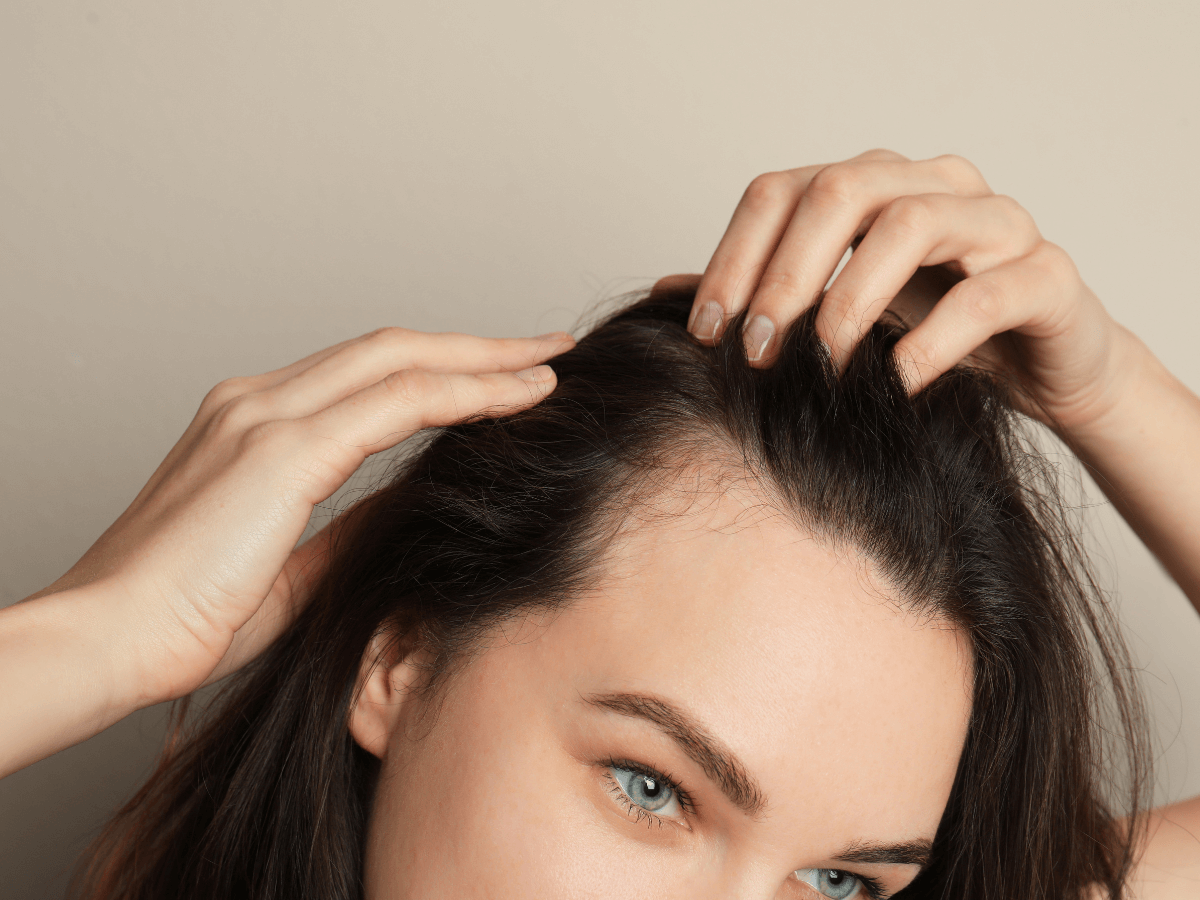Let’s clear this up right away: Hair loss after birth is very normal. More than normal actually–it’s almost always expected. But even though most moms go through it, there’s still no doubt that postpartum hair loss can cause a lot of negative or unwanted emotions.
Whether you’re preparing for the postpartum stage or currently deep in, understanding the causes, timeline, and treatment options for postpartum hair loss is the key to getting through it fast.
Causes of Postpartum Hair Loss
In normal pre-pregnancy hair, there are three stages of hair growth, according to the National Library of Medicine. They are anagen, catagen and telogen. Learning about each stage is necessary to understand what causes postpartum hair loss.
Anagen is known as the growth stage of your hair and is the longest phase in the cycle. During this time, new hair fibers are formed from cells at the base of the follicle, which then slowly grow outwards as the hair we see. The anagen stage usually lasts for several years and can be extended depending on various factors such as genetics, health issues, and lifestyle habits.
Catagen is the second stage of the hair growth cycle. This period lasts for about two to three weeks and is also known as the transition phase. The hair follicle will detach from its root and slowly shrink in size and stop growing. During catagen, cells below the surface of the scalp are resting and not actively growing.
Telogen is the final stage of your hair cycle. It’s considered the resting phase, or shedding phase, in which existing hairs are dormant and begin to shed. During telogen, hair follicles completely rest and do not produce any new hairs. As a result, no new hairs will grow during this period until it’s complete and the anagen phase begins again. The length of telogen varies from person to person but typically lasts three to four months.
Essentially, when you are expecting, an overflow of pregnancy hormones triggers your hair to get stuck in the anagen stage, or growth period. After birth, estrogen levels drop and hair transitions into shedding again jumping back into the telogen phase with an excess amount of hair waiting to be shed. This is why you will notice large clumps of hair falling out or thin spots on your scalp.
Does postpartum hair loss happen to all moms?
40 to 50 percent of moms experience some sort of postpartum hair loss, according to the American Pregnancy Association. It can depend on a lot of factors including age, genetics, nutrition, and hormones. Some moms will notice it more than others, some might not even notice it at all. Just know that either way, it’s all normal.
When Does Postpartum Hair Loss Start?
Hormonal shifts cause hair loss to typically begin 2 to 6 months postpartum. “Though it sometimes occurs sooner or later than this,” states Dr. Leah Ansell, MD, FAAD, a leading Board-Certified Dermatologist at Treiber Dermatology Associates based in Rye, New York. There is no strict countdown to when postpartum hair loss will start – everyone is different.
Signs of Postpartum Hair Loss
Not sure if you’re experiencing normal hair shedding or if it’s postpartum hair loss? If you gave birth a few months ago, you might be in that golden time frame. Here are some signs moms notice when going through their postpartum period hair loss stage.
- Seeing more hairs in your brush than usual
- Frequently finding extra hair strands on the floor
- Pulling out excessive hair clumps in the shower
- Noticing thin or bald spots on your scalp
How Long Does Postpartum Hair Loss Last?
There’s no definite time frame on when postpartum hair loss stops. Many factors can determine how long the cycle will be, so there is really no true number. “I say that it starts and rapidly accelerates,” says Ansell. “This usually lasts 2 to 6 weeks then plateaus.”
After about two months the majority of women will start to see improvement day by day until one day it returns to normal. The American Academy of Dermatology suggests that moms will likely regain their normal hair growth by their baby’s first birthday!
Postpartum Hair Loss Treatment
So many feelings can come with postpartum hair loss: embarrassment, self-consciousness, sadness, and even anger. This is why so many moms who experience hair loss want to try and find a solution. Let’s take a look at both natural and medical treatments moms can take advantage of.
Natural treatment
There are many postpartum hair loss vitamins (including vitamin D, vitamin C, and prenatal vitamins), oils, and hair care products on the market that claim to cure hair loss. But most dermatologists and experts agree that time is the only thing that really helps. “Eating a healthy diet and reducing stress as you are able will help your hair return to its baseline state,” notes Ansell. Nutritional deficiencies can slow the hair growth process which is what you don’t want to do. Stay away from processed foods, and aim for a whole-food diet. Plus, don’t forget to hydrate!
Medical treatment
What about any medical treatments? In general, experts suggest waiting, but if your hair loss is severe and isn’t improving, there are medical treatments you can pursue. “Some patients elect to do procedures such as platelet-rich plasma (PRP) to help encourage growth,” says Ansell.
- Platelet Rich Plasma (PRP) Therapy – PRP helps hair follicles become nourished again, according to Aboutanos Plastic Surgery, a medical center providing this service in Richmond, Virginia. A specialist will take platelets from your own blood and inject them into your scalp where the hair follicles are. This delivers nourishment and protein to promote new, thicker, and fuller growth. PRP therapy has actually been seen to be effective in roughly 70 percent of cases.
If you’re looking to seek medical treatment, please ask your doctor first about your options. We know it sounds cliche, but overall, time is the best treatment. “I try to reassure patients that it will end and the hair will regrow–without any intervention,” notes Ansell.
When to See a Doctor
As hormone levels change, your hair will usually slow down on shedding and return to its normal state soon. But Dr. Ansell warns “If the shedding continues to accelerate, lasts more than 3 months, or you notice bald spots appearing or thinning on the scalp,” that’s when you should seek medical help. Your doctor will come up with some treatment plans and go over any other options for you.
Does Postpartum Hair Loss Grow Back?
The good news is that it is possible for a new mom’s healthy hair growth can return after postpartum hair loss. “There will be numerous short wispy hairs that will regrow and fill in all areas where hair was lost,” reassures Ansell. Many moms feel confident about their hair health again months later and go on to tame all those wisps of hair with happiness.
Remember, postpartum hair loss is a temporary phase. By taking the time to learn and understand the hair growth cycle, it’s easier to process those pesky shedding hairs. With some patience and self-care, you can navigate this period with confidence knowing it’s all a natural process your body is going through.
Disclaimer: All content within this site is not intended as medical diagnosis or treatment and should not be considered a substitute for, nor does it replace, professional medical advice, diagnosis, or treatment. You are solely responsible for ensuring that any health or nutritional information obtained is accurate.
Experts in this article:
Dr. Leah Ansell, MD, FAAD, is a leading Board-Certified Dermatologist at Treiber Dermatology Associates based in Rye, New York. Dr. Ansell’s expertise includes medical, pediatric and cosmetic dermatology.




